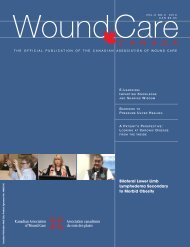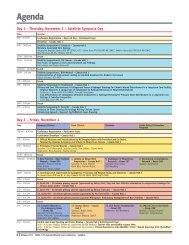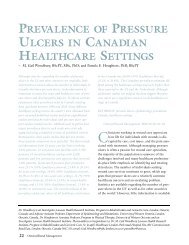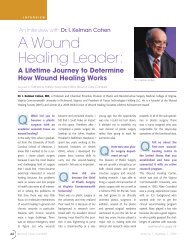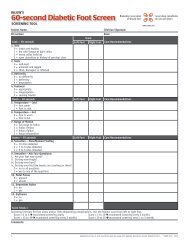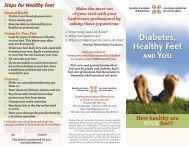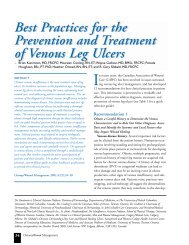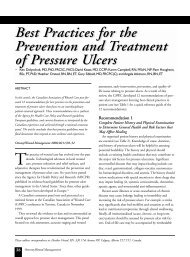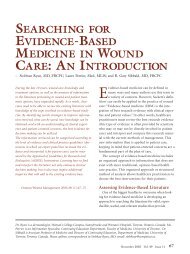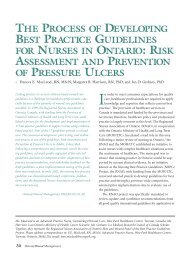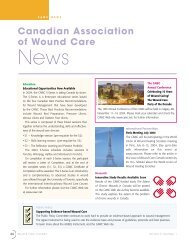Monitoring Hydration Status in Our Clients - Canadian Association of ...
Monitoring Hydration Status in Our Clients - Canadian Association of ...
Monitoring Hydration Status in Our Clients - Canadian Association of ...
You also want an ePaper? Increase the reach of your titles
YUMPU automatically turns print PDFs into web optimized ePapers that Google loves.
18<br />
F E A T U R E<br />
The Importance <strong>of</strong><br />
<strong>Monitor<strong>in</strong>g</strong> <strong>Hydration</strong><br />
<strong>Status</strong> <strong>in</strong> <strong>Our</strong> <strong>Clients</strong><br />
BY Chris Fraser<br />
Chris Fraser,<br />
HBSc, RD,<br />
provides nutrition<br />
<strong>in</strong>tervention for patients<br />
<strong>in</strong> the sp<strong>in</strong>al cord <strong>in</strong>jury<br />
and acquired bra<strong>in</strong><strong>in</strong>jury<br />
rehabilitation programs<br />
at the Parkwood<br />
Hospital site <strong>of</strong> St.<br />
Joseph’s Health Care <strong>in</strong><br />
London, Ontario, and is<br />
a member <strong>of</strong><br />
Parkwood’s Chronic<br />
Wound and Sk<strong>in</strong> Health<br />
Team. She has presented<br />
on nutrition and<br />
wound management<br />
extensively throughout<br />
Canada and has been a<br />
frequent author <strong>of</strong><br />
wound-related articles.<br />
She is a member <strong>of</strong> the<br />
College <strong>of</strong> Dietitians <strong>of</strong><br />
Ontario and Dietitians<br />
<strong>of</strong> Canada.<br />
M<br />
ost people do not th<strong>in</strong>k <strong>of</strong> water as a<br />
nutrient, but it is! In fact, water is the most<br />
essential <strong>of</strong> all nutrients. The average<br />
adult body can live for weeks without food, but for only<br />
days without water.<br />
Dehydration is a risk factor for impaired sk<strong>in</strong> <strong>in</strong>tegrity,<br />
and the presence <strong>of</strong> a wound can predispose a client<br />
to dehydration and malnutrition, result<strong>in</strong>g <strong>in</strong> a vicious<br />
cycle <strong>of</strong> sk<strong>in</strong> breakdown, malnutrition, and dehydration.<br />
<strong>Clients</strong> who are dependent on others<br />
for eat<strong>in</strong>g and dr<strong>in</strong>k<strong>in</strong>g are at the<br />
highest risk for malnutrition<br />
and dehydration.<br />
Dehydration <strong>in</strong><br />
the Older Adult<br />
Dehydration is among<br />
the most common reasons<br />
for hospitalization <strong>in</strong><br />
older adults. Physiological<br />
changes occur dur<strong>in</strong>g the<br />
ag<strong>in</strong>g process that can affect<br />
fluid balance, which <strong>in</strong>creases the<br />
risk for dehydration. As people age,<br />
total body water decreases, result<strong>in</strong>g <strong>in</strong> a<br />
decreased fluid reserve. Decreased ability <strong>of</strong> the<br />
older kidney to concentrate ur<strong>in</strong>e, decreased thirst<br />
sensation, changes <strong>in</strong> hormonal levels that affect the<br />
kidney and hydration status, effects <strong>of</strong> medications<br />
such as diuretics, changes <strong>in</strong> mobility, cognition and<br />
<strong>in</strong>dependence, and self-imposed fluid restriction<br />
because <strong>of</strong> fear <strong>of</strong> <strong>in</strong>cont<strong>in</strong>ence or nocturia are just<br />
some <strong>of</strong> the other factors that <strong>in</strong>crease the risk <strong>of</strong><br />
dehydration <strong>in</strong> the older adult.<br />
<strong>Hydration</strong> <strong>Status</strong> = Intake m<strong>in</strong>us Output<br />
It is essential that as health-care providers we closely<br />
monitor our clients’ fluid <strong>in</strong>take, compare <strong>in</strong>take to<br />
assessed fluid requirements and be aware <strong>of</strong> the<br />
potential signs and symptoms <strong>of</strong> dehydration. The<br />
recommended fluid <strong>in</strong>take for hydrated clients<br />
without abnormal losses is generally 27–30 mL per<br />
kilogram <strong>of</strong> body weight. The m<strong>in</strong>imum fluid<br />
consumption for older adults is 1,500 mL per day.<br />
Younger clients may need 35 mL or<br />
more per kilogram <strong>of</strong> body weight<br />
per day.<br />
It is equally imperative that<br />
routes and extent <strong>of</strong> fluid<br />
losses be identified and<br />
considered. Even small<br />
fluid losses equall<strong>in</strong>g<br />
three to six per cent <strong>of</strong><br />
body weight (e.g., a<br />
1.7–3.4 kg [3.75–7.5 lb]<br />
loss <strong>in</strong> a 56.8 kg [125 lb]<br />
client) can cause fatigue,<br />
weakness and confusion. The<br />
most common routes <strong>of</strong> fluid loss are:<br />
■ the gastro<strong>in</strong>test<strong>in</strong>al tract, with excessive<br />
losses occurr<strong>in</strong>g with frequent loose stools/diarrhea,<br />
overuse <strong>of</strong> laxatives and vomit<strong>in</strong>g<br />
■ the ur<strong>in</strong>ary tract, with excessive losses occurr<strong>in</strong>g<br />
with diuretic use and uncontrolled diabetes<br />
■ fever/sweat<strong>in</strong>g<br />
■ wound exudate<br />
■ negative pressure therapy and air-fluidized beds<br />
■ the respiratory tract, with greater losses occurr<strong>in</strong>g<br />
with conditions that elevate the respiratory rate<br />
Wound Care Canada Volume 7, Number 1, 2009
Parameters <strong>of</strong> <strong>Hydration</strong> <strong>Status</strong><br />
A client’s hydration status can be measured via several<br />
parameters.<br />
Weight—mild to severe dehydration can manifest as a<br />
rapid five to over 10 per cent loss <strong>in</strong> body weight.<br />
Blood pressure—low blood pressure or orthostatic<br />
hypotension (a rapid drop <strong>in</strong> blood pressure when<br />
go<strong>in</strong>g from ly<strong>in</strong>g to sitt<strong>in</strong>g or from sitt<strong>in</strong>g to stand<strong>in</strong>g)<br />
may <strong>in</strong>dicate dehydration.<br />
Ur<strong>in</strong>e output—a reduction <strong>in</strong> ur<strong>in</strong>e production from typical<br />
volumes generally <strong>in</strong>dicates a decrease <strong>in</strong> fluid <strong>in</strong>take.<br />
BUN:serum creat<strong>in</strong><strong>in</strong>e ratio—an elevated blood<br />
urea nitrogen (BUN) level with a normal or low serum<br />
creat<strong>in</strong><strong>in</strong>e level may <strong>in</strong>dicate under-hydration; however,<br />
an elevated BUN alone may not be an accurate <strong>in</strong>dicator<br />
<strong>of</strong> hydration status, especially <strong>in</strong> clients with renal<br />
impairment. A BUN: serum creat<strong>in</strong><strong>in</strong>e ratio greater than<br />
20:1 is a red flag for dehydration.<br />
Serum sodium—an elevated serum sodium level may<br />
<strong>in</strong>dicate dehydration; however, because other factors<br />
may impact the serum sodium level this should not<br />
be used alone to identify dehydration.<br />
When dehydration has been identified and a rehydration<br />
plan has been <strong>in</strong>itiated, it is important to<br />
monitor the client’s alertness, ur<strong>in</strong>e output, blood<br />
pressure, pulse and daily weight.<br />
Consequences <strong>of</strong> Dehydration<br />
Dehydration is one <strong>of</strong> the most common nutritionrelated<br />
problems <strong>in</strong> long-term care; it can be life<br />
threaten<strong>in</strong>g and may result <strong>in</strong> the follow<strong>in</strong>g:<br />
Risk factors or “clues” that your client may be at risk<br />
for becom<strong>in</strong>g dehydrated<br />
■ decreased physical and cognitive functional abilities,<br />
lethargy and confusion<br />
■ impaired balance and <strong>in</strong>creased risk for falls and<br />
fractures<br />
■ <strong>in</strong>creased risk for ur<strong>in</strong>ary tract and other <strong>in</strong>fections<br />
■ decreased sk<strong>in</strong> turgor and elasticity result<strong>in</strong>g <strong>in</strong> sk<strong>in</strong><br />
tears, shear <strong>in</strong>juries and pressure ulcers<br />
■ constipation and fecal impaction/obstruction<br />
■ ischemia and myocardial <strong>in</strong>farction<br />
■ renal failure<br />
■ death<br />
Signs and symptoms that your client is dehydrated<br />
■ Decreased ur<strong>in</strong>e<br />
output<br />
■ Dark, concentrated<br />
and/or strongsmell<strong>in</strong>g<br />
ur<strong>in</strong>e<br />
■ Frequent ur<strong>in</strong>ary<br />
tract <strong>in</strong>fections<br />
■ Dry lips/mouth and<br />
thick, str<strong>in</strong>gy saliva<br />
■ Constipation<br />
■ Dizz<strong>in</strong>ess when sitt<strong>in</strong>g<br />
up or stand<strong>in</strong>g<br />
■ Confusion or change<br />
<strong>in</strong> mental status<br />
■ Weight loss <strong>of</strong> 1.5 kg<br />
(3.5 lb) <strong>in</strong> less than<br />
seven days<br />
■ Fever<br />
Fluid Needs for Health<br />
Most people need at least eight cups <strong>of</strong> non-caffe<strong>in</strong>ated<br />
fluids daily. Dr<strong>in</strong>ks that conta<strong>in</strong> caffe<strong>in</strong>e, such as c<strong>of</strong>fee,<br />
tea and cola, should be taken <strong>in</strong> moderation only.<br />
The best way to ensure that your client consumes at<br />
least eight cups <strong>of</strong> fluids daily is to make available<br />
and encourage <strong>in</strong>take <strong>of</strong> water, juices, milk, broth and<br />
other non-caffe<strong>in</strong>ated beverages.<br />
cont<strong>in</strong>ued on page 20<br />
■ Dysphagia (swallow<strong>in</strong>g difficulties), especially with th<strong>in</strong> fluids<br />
■ Refusal <strong>of</strong> fluids at meal/snack times (this may be seen with dysphagia)<br />
■ The need for assistance with eat<strong>in</strong>g and dr<strong>in</strong>k<strong>in</strong>g<br />
■ Lack <strong>of</strong> or blunted thirst sensation<br />
■ Inability to communicate thirst and other needs<br />
■ Memory problems/forgetfulness<br />
■ Presence <strong>of</strong> an illness that <strong>in</strong>creases fluid lost from the body (e.g., vomit<strong>in</strong>g, diarrhea, fever with sweat<strong>in</strong>g,<br />
uncontrolled diabetes)<br />
■ Fluid losses (e.g., from ur<strong>in</strong>e, diarrhea, vomit<strong>in</strong>g, sweat<strong>in</strong>g, drool<strong>in</strong>g) are greater than fluid <strong>in</strong>take<br />
■ Regular use <strong>of</strong> medications such as diuretics, laxatives or enemas<br />
■ Intentional fluid restriction for fear <strong>of</strong> bladder <strong>in</strong>cont<strong>in</strong>ence/nocturia<br />
■ Decreased sk<strong>in</strong><br />
elasticity, such as<br />
on the arm that, when<br />
gently p<strong>in</strong>ched, does<br />
not spr<strong>in</strong>g back <strong>in</strong>to<br />
place but rema<strong>in</strong>s<br />
“p<strong>in</strong>ched up” when<br />
released<br />
■ Sunken eyeballs<br />
Volume 7, Number 1, 2009 Wound Care Canada<br />
19
20<br />
TABLE 1<br />
The approximate fluid provision from<br />
common foods<br />
Food Serv<strong>in</strong>g size Approx. fluid provided<br />
Jelly dessert/gelat<strong>in</strong> 125 mL (1/2 cup) 120 mL<br />
Pudd<strong>in</strong>g 125 mL (1/2 cup) 100 mL<br />
Ice cream/sherbet 125 mL (1/2 cup) 60 mL<br />
Popsicle 1 popsicle 90 mL<br />
Yogurt 125 mL (1/2 cup) 90 mL<br />
Canned fruit 125 mL (1/2 cup) 100 mL<br />
Soup 375 mL (1 1/2 cups) 165 mL<br />
Some foods—such as jelly dessert, pudd<strong>in</strong>g, ice cream,<br />
soup and canned fruit—conta<strong>in</strong> or are made with<br />
enough fluid that they can significantly contribute to<br />
a client’s fluid needs (Table 1).<br />
Dysphagia (swallow<strong>in</strong>g problems)<br />
Some clients may not be able to safely dr<strong>in</strong>k th<strong>in</strong> (regular)<br />
liquids. If your client has been appropriately assessed<br />
and advised to avoid th<strong>in</strong> fluids, it may be recommended<br />
that the follow<strong>in</strong>g fluids and food items be avoided:<br />
■ water, ice cubes, ice chips<br />
■ s<strong>of</strong>t dr<strong>in</strong>ks, all juices<br />
■ milk<br />
■ tea/c<strong>of</strong>fee<br />
■ broth and cream soups<br />
■ liquid supplements/meal replacements<br />
■ ice cream, sherbet, milkshakes, jelly dessert<br />
Individual recommendations and/or exceptions may<br />
be made based on <strong>in</strong>dividual client assessment. Ice<br />
cream, sherbet, milkshakes, jelly dessert, ice cubes and<br />
ice chips may not seem like th<strong>in</strong> fluids, but if they sit<br />
out at room temperature or are held <strong>in</strong> the mouth<br />
before swallow<strong>in</strong>g they will melt and become th<strong>in</strong>, and<br />
are therefore considered th<strong>in</strong> fluids.<br />
Table 2 shows a sample plan giv<strong>in</strong>g the number and<br />
volume <strong>of</strong> fluid products <strong>of</strong> pudd<strong>in</strong>g consistency that<br />
are needed throughout the day to provide approximately<br />
eight cups (2 L) <strong>of</strong> available fluid to meet a<br />
client’s fluid needs.<br />
Please note that this is just an example, and may not<br />
apply to your client on thickened fluids. It is recom-<br />
mended that a registered dietitian be consulted to<br />
<strong>in</strong>dividualize a thickened fluid plan to meet a client’s<br />
hydration needs.<br />
References<br />
1. Chern<strong>of</strong>f R. Thirst and fluid requirements. Nutrition Reviews.<br />
1994;52(8):S3-S5.<br />
2. Chidester JC, Spangler AA. Fluid <strong>in</strong>take <strong>in</strong> the <strong>in</strong>stitutionalized<br />
elderly. The Journal <strong>of</strong> the American Dietetic <strong>Association</strong>. 1997;97<br />
(1):23-28.<br />
3. Ford D, Roberts B. Avoid<strong>in</strong>g dehydration. Nurs<strong>in</strong>g. 1995;25(8):<br />
32CC-32DD,32HH.<br />
4. Fraser C. Practical considerations for the enhancement <strong>of</strong><br />
nutrition and hydration <strong>in</strong> patients. Wound Care Canada. 2008;6(1):<br />
54-55,81.<br />
5. Morris J, Lipsitz LA, Murphy K, Belleville-Taylor P. Quality Care <strong>in</strong> the<br />
Nurs<strong>in</strong>g Home. St. Louis: Mosby. 1997.<br />
6. Niedert KC, ed. Nutrition Care <strong>of</strong> the Older Adult: A Handbook for<br />
Dietetics Pr<strong>of</strong>essionals Work<strong>in</strong>g Throughout the Cont<strong>in</strong>uum <strong>of</strong> Care.<br />
Chicago: The American Dietetic <strong>Association</strong>. 1998.<br />
7. We<strong>in</strong>berg AD, M<strong>in</strong>aker KL. Dehydration: Evaluation and management<br />
<strong>in</strong> older adults. JAMA: The Journal <strong>of</strong> the American Medical<br />
<strong>Association</strong>. 1995;274(19):1552-1556.<br />
Wound Care Canada Volume 7, Number 1, 2009<br />
TABLE 2<br />
A sample thickened fluid plan<br />
This sample thickened fluid plan specifies fluid<br />
provision only and does not <strong>in</strong>clude foods consumed<br />
<strong>in</strong> meals and snacks; foods are over and<br />
above the fluid sources <strong>in</strong>dicated.<br />
Meal/snack Thick fluid Serv<strong>in</strong>g size<br />
Breakfast Thick juice 250 mL (1 cup)<br />
Pureed fruit<br />
Thick, set-style<br />
125 mL (1/2 cup)<br />
yogurt 250 mL (1 cup)<br />
Morn<strong>in</strong>g snack Thick juice 250 mL (1 cup)<br />
Pudd<strong>in</strong>g 125 mL (1/2 cup)<br />
Lunch Thick stra<strong>in</strong>ed<br />
soup 250 mL (1 cup)<br />
Thick juice<br />
Thick milk<br />
250 mL (1 cup)<br />
or pudd<strong>in</strong>g 125 mL (1/2 cup)<br />
Afternoon snack Pureed fruit 250 mL (1 cup)<br />
D<strong>in</strong>ner Thick soup 250 mL (1 cup)<br />
Thick juice<br />
Pureed fruit<br />
125 mL (1/2 cup)<br />
or pudd<strong>in</strong>g 125 mL (1/2 cup)<br />
Even<strong>in</strong>g snack Thick juice 125 mL (1/2 cup)



